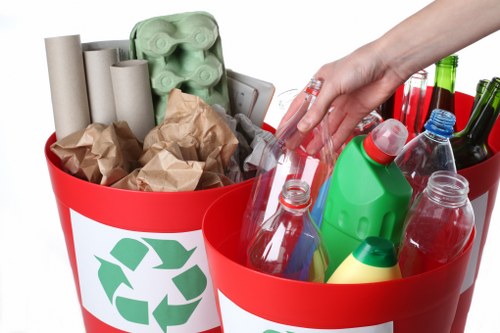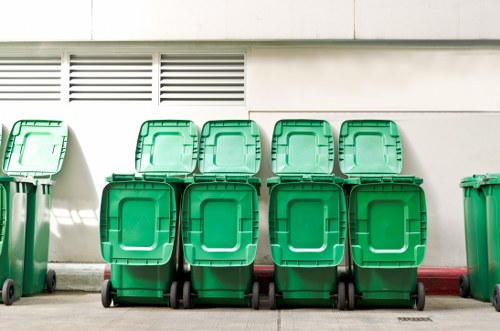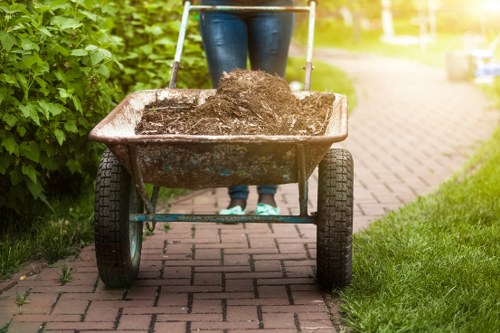Waste Clearance in Rubbish Removals

Waste clearance plays a crucial role in maintaining cleanliness and hygiene in both residential and commercial spaces. Efficient rubbish removals ensure that unwanted materials are disposed of responsibly, minimizing environmental impact and promoting a healthier living environment.
Whether you're renovating your home, decluttering your office, or managing construction debris, understanding the nuances of waste clearance can significantly streamline the process. This article delves into the essentials of waste clearance in rubbish removals, offering insights and tips to make your waste management efforts effective and eco-friendly.
Proper waste clearance not only enhances the aesthetic appeal of your space but also fosters sustainability by encouraging proper recycling and disposal methods. In the following sections, we will explore the different types of waste, the benefits of professional rubbish removal services, and best practices for efficient waste management.
Understanding Waste Clearance

Waste clearance refers to the systematic process of removing and disposing of unwanted materials. This process involves the collection, transportation, and disposal of various types of waste, ensuring that they are managed in an environmentally responsible manner.
There are several categories of waste that fall under rubbish removals, including household waste, commercial waste, and construction debris. Each category requires specific handling procedures to comply with local regulations and sustainability practices.
Effective waste clearance strategies can help reduce the volume of waste sent to landfills, promote recycling and reuse, and minimize the carbon footprint associated with waste management activities.
Types of Waste in Rubbish Removals

Understanding the different types of waste is fundamental to efficient rubbish removal. The primary categories include:
- Household Waste: Everyday items discarded from homes, such as food scraps, packaging materials, and broken appliances.
- Commercial Waste: Waste generated by businesses, including office supplies, electronic waste, and promotional materials.
- Construction Debris: Materials from building projects, such as concrete, wood, metals, and insulation.
- Hazardous Waste: Potentially dangerous materials like batteries, paint, and chemicals that require special handling.
- Electronic Waste: Discarded electronic devices like computers, smartphones, and televisions.
The Waste Clearance Process

The waste clearance process involves several key steps designed to ensure efficient and responsible rubbish removal:
- Assessment: Evaluating the amount and type of waste to determine the appropriate removal strategy.
- Collection: Gathering the waste from the source location using suitable containers and vehicles.
- Transportation: Moving the collected waste to designated disposal or recycling facilities.
- Disposal: Properly disposing of waste in compliance with environmental regulations.
- Recycling and Reuse: Sorting and processing materials that can be recycled or repurposed to reduce overall waste.
Each step must adhere to safety standards and environmental guidelines to minimize negative impacts and promote sustainability.
Benefits of Professional Rubbish Removal Services

Opting for professional rubbish removal services offers numerous advantages over DIY waste clearance:
- Efficiency: Trained professionals can swiftly and effectively remove large volumes of waste, saving you time and effort.
- Safety: Proper handling and disposal of hazardous materials reduce the risk of accidents and environmental harm.
- Compliance: Professionals are knowledgeable about local regulations and ensure that waste is managed legally and responsibly.
- Environmental Responsibility: Many rubbish removal services prioritize recycling and sustainable disposal methods, contributing to environmental conservation.
- Cost-Effective: While there is an upfront cost, professional services can prevent potential fines and reduce the need for multiple disposal trips.
Choosing a reputable rubbish removal service can enhance your waste management efforts, providing peace of mind and supporting a cleaner, greener environment.
Best Practices for Effective Waste Clearance

Implementing best practices in waste clearance ensures that rubbish removals are conducted efficiently and sustainably. Here are some essential tips:
- Sort Your Waste: Separate recyclables, hazardous materials, and general waste to streamline the removal process and facilitate recycling efforts.
- Reduce Waste Generation: Minimize the amount of waste produced by opting for reusable items, repairing instead of discarding, and being mindful of consumption patterns.
- Choose the Right Containers: Use appropriate bins and containers for different types of waste to simplify sorting and handling.
- Schedule Regular Pickups: Establish a consistent waste removal schedule to prevent accumulation and ensure timely disposal.
- Partner with Responsible Services: Select rubbish removal companies committed to eco-friendly practices and compliance with environmental standards.
Adhering to these practices can significantly improve the effectiveness of your waste clearance efforts, promoting sustainability and operational efficiency.
Complying with Waste Disposal Regulations

Compliance with local waste disposal regulations is paramount to avoiding legal repercussions and ensuring responsible waste management. Key considerations include:
- Understanding Local Laws: Familiarize yourself with municipal and regional regulations governing waste clearance and rubbish removals.
- Proper Documentation: Maintain records of waste disposal activities, including receipts and transfer documentation.
- Handling Hazardous Materials: Ensure that hazardous waste is disposed of through authorized channels and in accordance with safety guidelines.
- Recycling Mandates: Adhere to recycling requirements by segregating recyclable materials and utilizing approved recycling facilities.
- Permits and Licenses: Obtain necessary permits for large-scale waste removal operations or specialized disposal activities.
Staying informed and compliant with waste disposal regulations not only prevents fines but also contributes to broader environmental protection efforts.
Choosing the Right Rubbish Removal Service

Selecting a reliable rubbish removal service is essential for effective waste clearance. Consider the following factors when making your choice:
- Reputation: Research customer reviews and testimonials to gauge the reliability and quality of the service provider.
- Services Offered: Ensure that the company offers the specific types of waste removal you require, whether it's residential, commercial, or construction debris.
- Pricing: Compare pricing structures to find a service that offers transparent and competitive rates without compromising on quality.
- Environmental Practices: Opt for companies that prioritize recycling and sustainable disposal methods to support eco-friendly initiatives.
- Availability: Choose a service that aligns with your schedule and can accommodate your waste removal needs promptly.
Taking the time to evaluate and select the right rubbish removal service can enhance your waste clearance experience, ensuring efficiency and peace of mind.
Innovations in Waste Clearance Technology

Advancements in technology are transforming the waste clearance landscape, making rubbish removals more efficient and sustainable. Some notable innovations include:
- Automated Sorting Systems: These systems enhance the accuracy and speed of waste sorting, improving recycling rates and reducing contamination.
- Smart Waste Management: IoT-enabled devices monitor waste levels in containers, optimizing collection routes and schedules.
- Eco-Friendly Disposal Methods: Technologies like plasma gasification and anaerobic digestion offer cleaner and more sustainable ways to process waste.
- Recycling Technologies: Innovations in recycling processes increase the range of materials that can be effectively recycled and repurposed.
- Data Analytics: Data-driven approaches help waste management companies optimize operations, reduce costs, and enhance service quality.
Embracing these technological advancements can significantly improve waste clearance operations, promoting efficiency and environmental stewardship.
Environmental Impact of Waste Clearance

Effective waste clearance has a profound impact on the environment. Proper rubbish removals help mitigate the adverse effects of waste accumulation, including:
- Reducing Landfill Burden: Efficient waste management decreases the volume of waste sent to landfills, prolonging their lifespan and reducing habitat disruption.
- Lowering Greenhouse Gas Emissions: Minimizing waste decomposition in landfills reduces methane emissions, a potent greenhouse gas contributing to climate change.
- Conserving Natural Resources: Recycling and reusing materials conserve valuable resources, decreasing the need for raw material extraction.
- Preventing Pollution: Proper disposal of hazardous waste prevents soil and water contamination, safeguarding ecosystems and human health.
- Promoting Biodiversity: Sustainable waste management practices help preserve natural habitats and support biodiversity conservation.
By prioritizing responsible waste clearance, individuals and businesses can contribute to environmental preservation and sustainability goals.
Future Trends in Rubbish Removals

The future of rubbish removals is poised for significant transformation, driven by evolving technologies and sustainability imperatives. Emerging trends include:
- Circular Economy Models: Emphasizing the reuse and recycling of materials to create a closed-loop system, reducing waste generation.
- Advanced Recycling Technologies: Innovations that enable the processing of previously non-recyclable materials, expanding recycling capabilities.
- AI and Machine Learning: Enhancing waste sorting accuracy and optimizing collection logistics through intelligent algorithms.
- Zero Waste Initiatives: Striving for waste-free operations by eliminating unnecessary waste and maximizing resource efficiency.
- Public Awareness Campaigns: Increasing education and awareness about waste management practices to encourage community participation.
Staying abreast of these trends will be essential for rubbish removal services aiming to remain competitive and aligned with global sustainability objectives.
Conclusion and Call to Action

Waste clearance in rubbish removals is a critical component of effective waste management, promoting cleanliness, environmental sustainability, and compliance with regulatory standards. By understanding the types of waste, leveraging professional services, and implementing best practices, individuals and businesses can achieve efficient and responsible rubbish removals.
As we look to the future, embracing technological advancements and sustainable practices will be paramount in enhancing waste clearance operations and minimizing environmental impact.
Don't let waste accumulate and harm your environment. Contact us today to learn more about our professional rubbish removal services and take the first step towards a cleaner, greener tomorrow.